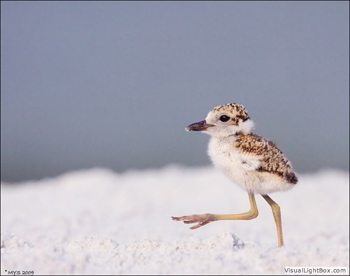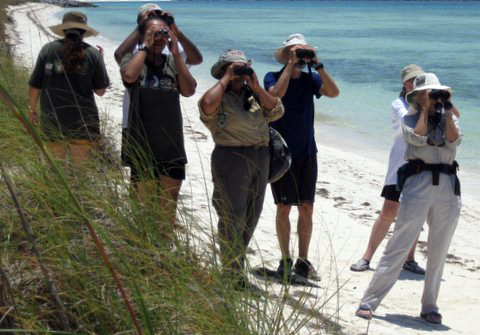|
From:TheBahamasWeekly.com Bird Talk - Erika Gates
Grand Bahama Island, Bahamas - During the months of June the beaches of Grand Bahama become busy with birds that spend their life at sea or over coastal waters but need to find a hospitable place to raise their young before returning back to the sea in August or early September. One of those birds is the Least Tern appropriately named as it is the smallest tern in the region measuring only 9 inches in length. Least Terns nest in colonies on sandy beaches and an become quite aggressive and noisy when defending their nests. The nest is merely a "scrape" in the sandy ground along the dune or above the high water mark and the eggs blend perfectly into their surroundings. They can easily be stepped on by beach goers. When the chick hatches it is able to walk almost immediately but it prefers to stay in the scrape for a while which makes it extremely vulnerable.
After a few days the parents will lead the chick into the surrounding shoreline vegetation for cover where they will bring a constant supply of small fish. They will hover over the shallow coastal waters and plunge-dive into the surf for their prey. The chick will grow fast and is able to fly after about 21 days. During this "growing up" period it is very vulnerable to dogs that are not kept on a leash and other predators like Laughing Gulls, cats and racoons.
A shorebird species that can be frequently found right amongst a Least Tern nesting colony is the Wilson's Plover, a permanant resident on our island. Wilson's Plovers' nests tend to be a little more elaborate as they like to lay their eggs into a scrape of pieces of washed-on vegetation which they may even surround with broken shells and small pieces of rocks or coral. This camouflages the eggs even more and, again, beachgoers should step carefully in such areas. It is always better to walk near the waters edge on the open, sandy stretch of beach in order to avoid crushing any eggs or chicks!
The Grand Bahama Birding Group has been monitoring sea and shorebird nesting sites over the years. They have been cordoning off beaches or dunes where the birds return every year, thereby preventing eggs and chicks being crushed by people walking or even cars driving over them. In conjunction with the Grand Bahama Ecotourism Association the G.B. Birding Group has installed signs at several sites to inform the public about the plight of nesting sea and shorebirds during the summer months.
Erika Gates is the owner of Kayak Nature Tours (one of the first Eco-Tour businesses in The Bahamas); co-founder of the Ecotourism Association; a published writer; and a Cacique award winner! Her column Bird Talk will enlighten and educate us about birds of The Bahamas, as well as the importance of Ecology. Erika can be reached at gbntours@hotmail.com or (242) 373-2485
|

